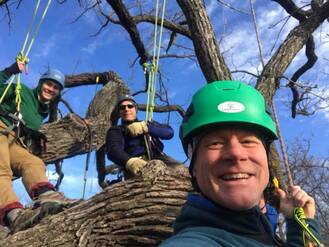 You don’t need to dig into research studies to know that teams that work well together tend to achieve great results. You can probably spot a high-performing team without much thought. Think about how everything comes together for your favorite sports team during a successful scoring drive. While ‘Hamilton’ might be a great musical, your enjoyment of the live performance is dependent upon the actors, musicians, sound and lighting crews being in-sync the night of your performance. In either case there are a number of team members involved. No matter how large the group is, it can produce good results when each member is focused and successfully completes their own task. Amazing results, however, can be achieved when members work together by performing their respective role while being supportive and encouraging of fellow teammates. This idea is at the heart of why team-builders and bonding events are used to improve a team’s overall performance. Aim Higher Companies and organizations spend a lot of time, money and energy looking for ways to improve morale and develop their employees and teams to help them achieve amazing results. Team-building exercises and social events are two ways they try to accomplish this. While there is plenty of research showing the value and benefits of these types of activities, in reality they are held in low regard by the majority of employees. Think of your own feelings when you hear you’ll be participating in a team-building exercise. When you’ve been in the position of planning such an event for your employees, colleagues, or group, did you sense a challenge of getting them motivated to participate? On one hand, you understand that team building exercises can be used to energize the group and improve morale and productivity. On the other hand, maybe your efforts have failed to achieve these goals, or worse, lead to anxiety and resentment. Unfortunately, many of the typical team-builders are structured or executed in a way that simply replicate the same patterns and struggles that already occur within the group. Give Them Something To Talk About To be successful today, you need to consider new ways to achieve the results you are looking for. There isn’t a single solution, but there are alternative methods to motivate and improve your team’s performance. Out of the ordinary experiences are a great way to break through some of the negative impressions people may have. Some of the more successful exercises I have come across have two things in common: they provide a “wow” factor and were not expressly designed as a traditional team-builder. Being somewhat obscure to the general public, recreational tree climbing is an activity that provides a “wow” factor for most people. Regardless of a person’s initial response being either one of excitement or one of apprehension, their curiosity is certainly piqued. Most fears and apprehension can be addressed through communication prior to activities like tree climbing. At the same time, it would be a mistake to assume that requiring each person to climb is necessary to achieve results. Spectators enjoy the activity and participate in the overall experience without ever leaving the ground. Watching people climb is exciting in itself. That boost in energy feeds the underlying desire to see people reach their goals and expresses itself through spectators and their use of words of encouragement towards participants. In addition, a climber’s ability to participate and reach their goal is not dependent upon the other climbers. This may sound contrary to the goal of traditional team building exercises that demonstrate how a team cannot achieve its goal without each person fulfilling an individual task. There are plenty of exercises out there to get that point across, including the daily work experience. As an alternative experience, the end result will demonstrate that while one may be focused on their individual task, their success is profoundly impacted by the support and encouragement they receive from others. In addition, they feel empowered to provide the same to the other participants. Our regular climbing events allow individuals to come to us to climb. These participants typically do not know the other climbers in the group. What consistently occurs with each group of participants is that they begin to relate to each other. In a short amount of time, complete strangers are in conversation together. Everyone is outside of their comfort zone dealing with their own challenges, which helps them relate to each other. This tends to manifest as a desire to help others achieve their goals. Teams that achieve amazing results are those that have members who are not only capable of performing their required task, but arguably more important, able to be supportive and encouraging of the others. Experiences like recreational tree climbing fosters this type of interaction amongst participants organically. Shoot for the Treetops I agree with Andre Lavoie, “creating bonding experiences employees actually like fosters a workplace culture of friendship, which directly improves morale and productivity.” These bonding experiences can come from a variety of unique and innovative activities. Recreational tree climbing is one option, but I am sure you can think of others that might achieve your objectives and goals. It can be challenging to avoid falling into the trap of pulling something out-of-the box that is easy to set up. Before you take the easy road, ask yourself how it will be received by your team and will it ultimately provide the result you desire? Need help aiming higher? Look into some unusual team-builders here. Of the groups who come to us for the recreational tree climbing experience, some will schedule an event as a stand-alone activity for a particular team or group. Others choose to offer it in conjunction with a company picnic or event. This can spice up a routine gathering while helping to avoid the anxiety some members might feel if it sounds too extreme for them. Even if you are the one who is apprehensive with such an activity and prefer to remain firmly on the ground, you may find yourself inspired to try it out after you see and understand the safety and control each climber has. Regardless of whether climbers have come to us for the therapeutic and developmental benefits or for recreational pleasure, each climber experiences a feeling of connection to the other individuals in the group they are climbing with. How do you think your group will feel and interact the next time they convene after sharing an experience like this? Start planning a tree-climbing experience for your group here.
0 Comments
Leave a Reply. |
AuthorAs a G.O.T.C. Recognized Master Instructor & Facilitator, I.S.A. Board Certified Master Arborist, and T.C.I.A. Certified Treecare Safety Professional, Curt has spent over 30 years dedicated to the study and care of trees. Categories
All
Archives
May 2024
|
|

 RSS Feed
RSS Feed
